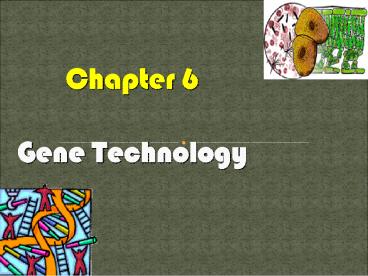Chapter 6 Gene Technology - PowerPoint PPT Presentation
Title:
Chapter 6 Gene Technology
Description:
Gene technology DNA recombinant technology Genetic engineering Gene cloning tools Target gene Cloning vector ... Explain gene cloning and its application. – PowerPoint PPT presentation
Number of Views:442
Avg rating:3.0/5.0
Title: Chapter 6 Gene Technology
1
Chapter 6Gene Technology
2
Chapter review
Gene technology
Ethics
DNA recombinant technology
Gene library
Application
Genetic engineering
Gene cloning
Genomic library
cDNA library
Transgenic organism
DNA finger printing
tools
Genetically modified organism
Target gene
Cloning vector
Restriction enzyme
Modifying enzyme
Host cell
Polymerase chain reaction
methods
3
At the end of the lesson, you should be able to
- Explain Recombinant DNA Technology (genetic
engineering) - Explain gene cloning and its application.
- List the tools used in recombinant DNA
technology. - Explain restriction enzyme
4
About DNA
- Presents in a chromosome cell and contains
genetic information for all living organisms.
5
Genetic Engineering
6
What is genetic engineering?
- The ability to take a specific gene from one cell
and place it into another cell where it is
expressed _at_ the direct manipulation of genes for
practical purposes.
7
What is genetic engineering?
What is genetic engineering?
- New DNA made by combining different DNA pieces
is known as recombinant DNA.
8
Biotechnology
- The manipulation of living organisms of their
components to produce useful products.
9
Biotechnology
- Used various techniques to changed living
organisms at the molecular level to produce/
provide good product and services. - Often referred to as genetic engineering.
10
Recombinant DNA Technology
11
Recombinant DNA Technology
- Special techniques produced from genetic
engineering process. - Technology that produced any DNA molecule made
in vitro with segments from different
sources/by combining genes from different
organisms.
12
Recombinant DNA Technology
- A new field of biology - started in the mid
1970s - Permits the formation of new combinations of
genes - By isolating genes from the organisms
- And introducing them into either a similar or
unrelated organism.
13
Recombinant DNA Technology
- By this method
- foreign DNA may be inserted not only in the
simple single cells of bacteria but also into
cells from the bodies of complex organisms - once inside the cells, this foreign DNA may be
expressed.
14
Recombinant DNA Technology Gene Cloning
15
Gene cloning
- DNA cloning is using the DNA manipulation
procedures to produce multiple copies of a single
gene or segment of DNA.
16
Gene cloning
Stages in gene cloning
Gene preparation
Vector insertion
Detection of cloned gene
Host cell transformation
17
Gene cloning
Stages in gene cloning
Gene preparation
18
Gene cloning
Stages in gene cloning
Vector insertion
19
Gene cloning
Stages in gene cloning
Host cell transformation
20
Recombinant DNA Technology Tools
21
Tools
DNA (gene) source
DNA cloning vector
DNA ligase
Restriction enzyme
Host cell
22
Chapter review
Gene technology
Types
YAC
Polymerase chain reaction
Target gene
bacteriophage
Taq Polymerase
cosmid
plasmid
Cloning vector
DNA ligase
Tools of DNA Recombinant Technology
Modifying enzyme
Types
characteristics
Host cell
Restriction enzyme
E. coli
characteristic
Types
Palindromic sequence concept
EcoRI
SmaI
23
Restriction enzymes
- Enzymes for cutting DNA
24
Restriction enzymes
- Class of enzyme that recognizes specific base
sequences of DNA and cut / cleaves the DNA
molecular at that side. - Today, more than 800 different types known.
25
Restriction enzymes
- In natural, these enzymes protect the bacteria
against intruding (interfering) DNA/RNA from
another organism like viruses. - The bacterial DNA was modified, so that it was
immuned to its own restriction enzyme
26
Restriction enzymes
Characteristics
- Have ability to splice through DNA at specific
sequence - different restriction enzyme cut a
particular base sequences, called restriction
sites.
27
Restriction enzymes
28
Restriction enzymes
Characteristics
- This enzymes recognize palindromic base sequences.
29
Restriction enzymes
Characteristics
palindrome
- The base sequences of one strand reads the same
as its compliment strands
30
Restriction enzymes
Characteristics
palindrome
SPELL THIS!
M
A
D
A
M
31
Restriction enzymes
Characteristics
- Example
5
3
G A A T T C
C T T A A G
5
3
32
Restriction enzymes
Characteristics
- RE hydrolyze the phophodiester backbone of each
strand
33
Restriction enzymes
Characteristics
- RE can produce two types of cutting pattern
- sticky end (EcoRI)
- blunt end (SmaI)
34
Restriction enzymes
Characteristics
EcoRI cutting pattern
35
Restriction enzymes
Characteristics
SmaI cutting pattern
36
Several types of restriction enymes
Types of RE































